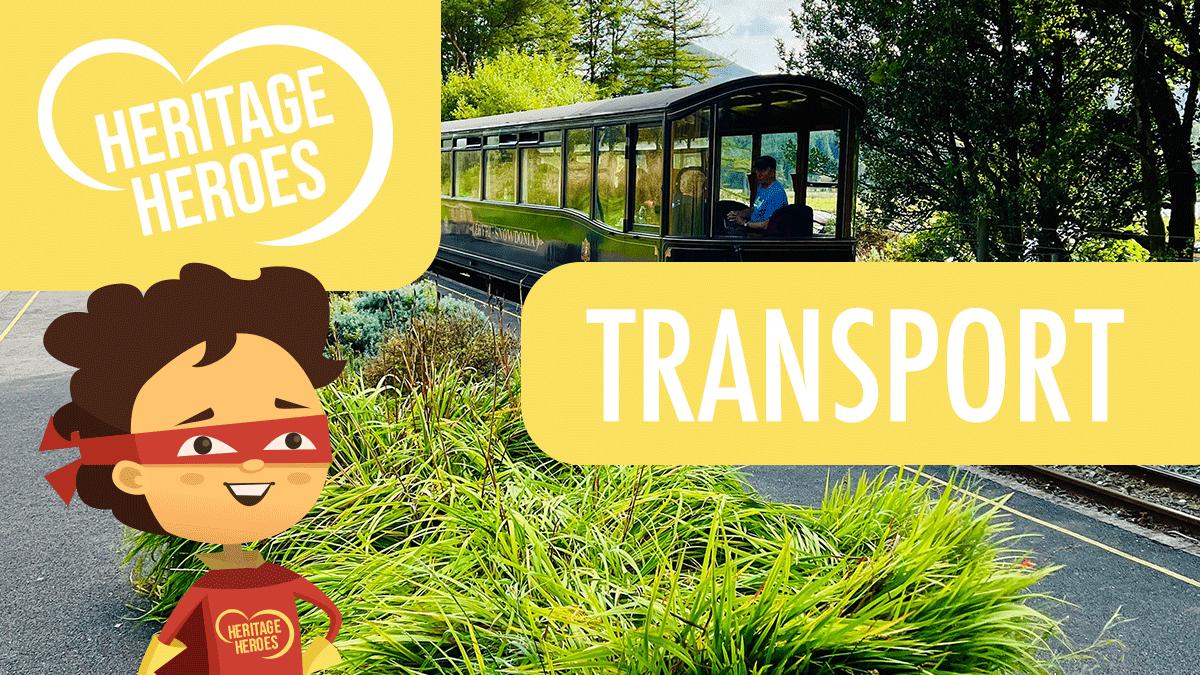Wherever you live, there’s treasure to be discovered!
Not just gold and gems, but stories of buildings, locations and people.
Our heritage is a great wealth… and it’s all around us. Sometimes standing proud in the open air – sometimes hidden behind some bushes.
And to help find it, we’re looking for Heritage Heroes – could you be one?
You can find clues in all sorts of places to find out what happened in your street, neighbourhood and further afield, from famous visitors to historic events.
Here are three tips to help you become a Heritage Hero…

HERITAGE HEROES. AN INSPIRING AUDIO PRODUCTION FOR FUN KIDS. MADE POSSIBLE WITH THE NATIONAL LOTTERY HERITAGE FUND, WITH THANKS TO NATIONAL LOTTERY PLAYERS.
Roads
For hundreds of years, the only way people got around was on foot, horse or cart.
Roads, if you could call them that, were mainly well trodden paths, although the odd Roman road still remained, just a little worn out!
As more and more people wanted to travel, better quality roads were needed and from the 18th century, organisations called turnpike trusts were established, charging users a toll to help maintain the roads.
It wasn’t until 1902 when the first ‘modern’ road – one covered with tarmac, was opened in Nottingham.
You can see evidence of these old paths and roads by looking for clues.
Some of the old toll houses still exist by the side of roads and bridges.
Coaching inns, which provided food, drink and rest for travellers until railways arrived, have sometimes been converted into pubs, offices or homes.
And look out for old bridges by the side of modern ones, and water crossings like fords.
Along the side of roads, you can sometimes find stone markers showing parish boundaries or the distance to the next town!
Waterways
Waterways, like rivers and canals, have been great ways for moving goods around the country for hundreds of years.
The network was expanded massively during the Industrial Revolution in the late 18th and early 19th centuries.
Generations of families lived and worked on the canals, including children who moved around the country with their families, often looking after the horses who pulled the boats, and rarely getting the chance to go to school!
In fact, Birmingham has more miles of canals than Venice and even Amsterdam!
You can find canals, locks, towpaths and wharfs where they loaded and unloaded goods all over the UK.
If you go online to waterways.org.uk, you can find out about canals near you.
Railways
Horses and canals could only move so much – and they were slow. In Victorian times, people wanted to travel further afield, move more and heavier goods and get there faster.
The railway network was born.
Victorian railways were built by individual companies, with their own logos, colour and shapes of locomotives.
By 1914, there was 20,000 miles of track, run by 120 competing companies, hence why some towns and cities had more than one station, each company wanted their own!
But railways weren’t just for people, they were primarily built to move food from farms and goods from the expanding number of factories and heavy industry.
Some of the other benefits that railways delivered…
They standardised time – in 1840 the Great Western Railway told all stations on Isambard Kingdom Brunel’s line from London to South West England to use London time. Before this , train drivers had to constantly adjust their watches to different time zones when they pulled into each station.
Dairy produce and fish could be delivered easily to different parts of the country within hours.
National newspapers flourished – and grew in number, as they could now be delivered everywhere

If you live near a station, why not visit and see if you can find clues to when it was built and by whom.
Look at the building design and any plaques that tell its history.
Have a think about what the place would have been like at that time and what goods might have been transported from the platforms.
Why don’t you design your own plaque for the station?
What symbols, facts and dates will you include?
Why doesn’t my town have a railway?
Whilst most large towns and cities might still have a railway today to bring people and goods in, a lot of places no longer have a station or indeed a local railway.
In the 1960s, with the rise in popularity of the car and after the devastation of the war, Government modernised the railways, electrifying some lines but closing over 2,300 stations and 6,500 miles of track.
Since the 1970s though, 460 miles have reopened as heritage railways. Go online to hra.uk.com to find out about heritage railways near you.
You can also see clues of old railways around and about – old stations may now be homes whilst some old lines are now cycle paths – still with their bridges, old telegraph poles and perhaps a tunnel.
Now it’s over to you! Here’s a reminder of things to look for to help you find out about the place where you live.
1 – Have a look on a map to see if you can spot an old path or road. And keep an eye out for old toll houses, coaching inns and stone markers. Why not draw your own map and mark on it things that you see.
2 – Check and see if you there’s a canal near you – why not see if you can follow in the footsteps of the canal families and walk along the route?
3 – Visit your local station or a heritage railway line and see who and when it was built. Remember to look at the architecture for clues, and maybe make a sketch or take a photo.
Here are some helpful links that will help you become a Heritage Hero!
Learn about Turnpike Roads: www.turnpikes.org.uk/
Explore a history of Canals: www.canalrivertrust.org.uk/
Discover a local Heritage Railways: www.hra.uk.com/
London Transport Museum: www.ltmuseum.co.uk/
Scotland Transport Museum: www.undiscoveredscotland.co.uk/glasgow/museumoftransport/index.html
Science and Industry Museum: www.scienceandindustrymuseum.org.uk/
Town Maps are great ways to learn: www.townmaps.history.ac.uk/
Canal Maps: www.canalmaps.net
History of Railways: www.nationalarchives.gov.uk/help-with-your-research/research-guides/railways
Learn more about Railways: www.railwaysarchive.co.uk









